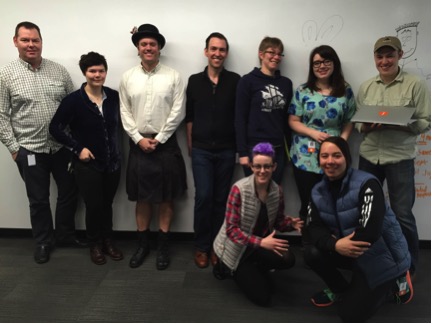Tags
"computer science"
Jama Software: Isabella Jorissen, Winter Shadow 2016

Me, 2nd from the left, with my host Chris McCraw, on my right, and the Support Ops team
Mustering up the will to get out of bed at 7 am on a rainy Monday in Portland is a lot easier if you have something to look forward to. I realize that 7 am isn’t early for some, but after two weeks of loafing around with my family, it was a bit of a rude awakening (pardon the pun). Each morning that week, the 99 bus shuffled me to the 6th and Yamhill, and from there I’d walk a few Portland-sized blocks to 2nd and Taylor.
At the corner of 2nd and Taylor is– you guessed it– Jama’s headquarters. The building owner has a penchant for old motorcycles, so the first-floor lobby sports four beautiful bikes (three Ducatis and a Norton, if memory serves). The second-floor lobby is no less eclectic, though that’s Jama’s doing. Anyone who visits the Jama office signs in with a living wall at their back and an inspirational mission statement on the wall to their right. A few of my favorite bits: “This is where we do our best work. It’s where we ask the tough questions and challenge the status quo… As an employee, partner, customer, or guest within our space, you are a member of Jama Nation… Let’s get to work.”
Jama Software focuses on one product, known as Jama. “Jama,” as it was put me by my externship host, “is a little bit of a Swiss army knife.” It’s often used by companies who have a lot of specifications, procedural oversight, or regulations to meet during the product development process. My externship host was Chris McCraw, team Lead for Support Ops. The Support Ops team, which served as a home base of sorts for me, manages any technical issues that might pop up on the customer side. They also maintain online a community where users can ask questions, read documentation, and learn how to make Jama work for them.
Continue reading Jama Software: Isabella Jorissen, Winter Shadow 2016
Presidents Summer Fellowship, Modeling Fluid Dynamics Part 3, Qiaoyu Yang
President’s Summer Fellow Qiaoyu Yang ’16, mathematics major, is testing a probabilistic particle model for studying fluid dynamics with Prof. Aleksandar Donev at the Courant Institute in New York City.
This summer, I worked with Prof. Aleksandar Donev in Courant Institute to perform particle simulation for chemically reactive fluid. In the following I will try to explain the essentials of the project.
Our research problem is to model reactive fluid. Traditionally, fluids’ dynamics are modeled mostly by differential equations. However, in our case, because of the chemical reactions involved, some assumptions about the fluid is very different from reality and this makes the results described by differential equation to be inaccurate. Therefore, we need to use some other methods.
Presidents Summer Fellowship, Modeling Fluid Dynamics Part 2, Qiaoyu Yang
President’s Summer Fellow Qiaoyu Yang ’16, mathematics major, is testing a probabilistic particle model for studying fluid dynamics with Prof. Aleksandar Donev at the Courant Institute in New York City. In this post, he explores the differences between research in applied versus pure math.
The end of summer approaches. So does my summer research at Courant Institute. It’s been an exciting and productive time. During my time at Reed, I have done several research projects, some in pure math and others in applied math. Among these experiences, I liked the one I did in my freshman summer and the one I did this summer the most. They feature different characteristics of research in pure and applied math. I think some of these differences are quite interesting and would like to share them to people interested in math and emphasize the distinctions between pure and applied math.
I did the first project in the summer of 2013 with Dave, i.e., Prof. David Perkinson, in the math department of Reed. We worked on combinatorics and graph theory, a branch of discrete math. On the other hand, the research project I did this summer is building a stochastic particle model. This is a topic in scientific computation, which is a part of applied math. In the following, I will try to compare my experiences and give the readers some flavors of what research is like in pure and applied math. Of course I need to admit that these are totally based on personal experience and they can be very biased. Also, I’m still learning about math, and a lot of things highly depend on the specific subject so my conclusions can be over-generalizing. But this is not writing a research paper so I don’t want to be too rigorous in all aspects.
Presidents Summer Fellowship, Modeling Fluid Dynamics, Qiaoyu Yang

President’s Summer Fellow Qiaoyu Yang ’16, mathematics major, is testing a probabilistic particle model for studying fluid dynamics with Prof. Aleksandar Donev at the Courant Institute in New York City.
After finishing my study abroad program in Moscow, I flew to NYC on May 23rd. The weather is terribly hot here. It took me two days to settle down and then I went to meet my supervisor, Prof. Aleksandar Donev, in the Courant Institute.
Courant is really amazing. It’s a leading center for research and education in applied mathematical science, as well as in computational and some fields of pure math. There are researchers working on different areas of mathematical science, such as computational biology, fluid dynamics, mathematical finance, and so on. Prof. Donev is working on computational physics and chemistry, so my project is also closely related to these two subjects.
Continue reading Presidents Summer Fellowship, Modeling Fluid Dynamics, Qiaoyu Yang
